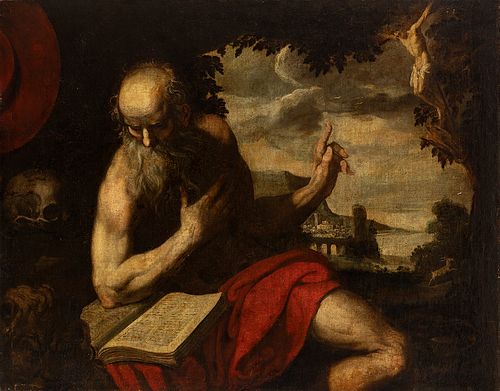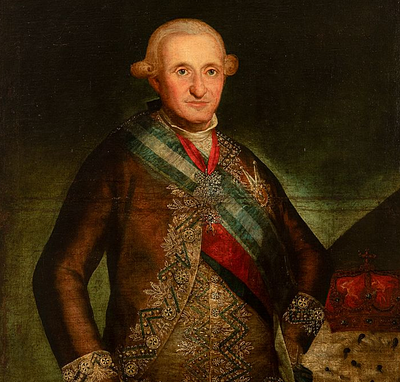Spanish school; 17th century. "San Jeronimo Penitent". Oil on canvas. Antique relined.
Lot 2
About Seller
Setdart Auction House
Carrer Aragó 346
Barcelona
Spain
Setdart Subastas was born in 2004 and is currently the first online art auction in Spain with solidity, prestige and reliability guaranteed by our more than 60,000 users. Setdart has a young, dynamic and enterprising team ready to successfully manage the purchase and sale of art works through custom...Read more
Estimate:
EUR€4,000 - EUR€5,000
$4,123.71 - $5,154.64
Absentee vs Live bid
Two ways to bid:
- Leave a max absentee bid and the platform will bid on your behalf up to your maximum bid during the live auction.
- Bid live during the auction and your bids will be submitted real-time to the auctioneer.
Bid Increments
| Price | Bid Increment |
|---|---|
| EUR€0 | EUR€10 |
| EUR€200 | EUR€25 |
| EUR€500 | EUR€50 |
| EUR€1,000 | EUR€100 |
| EUR€3,000 | EUR€200 |
| EUR€5,000 | EUR€500 |
| EUR€10,000 | EUR€1,000 |
| EUR€20,000 | EUR€2,000 |
| EUR€50,000 | EUR€5,000 |
About Auction
By Setdart Auction House
Sep 22, 2021
Set Reminder
2021-09-22 09:30:00
2021-09-22 09:30:00
America/New_York
Bidsquare
Bidsquare : 22nd September - ARAS JÁUREGUI Private Collection - Old Masters, 19th & 20th Century
https://www.bidsquare.com/auctions/setdart-auction-house/22nd-september---aras-j-uregui-private-collection---old-masters-19th-20th-century-7427
ARAS JÁUREGUI Private Collection - Old Masters, 19th & 20th Century Setdart Auction House sofia@setdart.com
ARAS JÁUREGUI Private Collection - Old Masters, 19th & 20th Century Setdart Auction House sofia@setdart.com
- Lot Description
Spanish school; 17th century. "San Jeronimo Penitent". Oil on canvas. Antique relined. It presents repainting, restorations and faults in the painting. Measurements: 95,5 x 121 cm. In this canvas the theme of Saint Jerome penitent in the desert is approached through a classical, clear and open composition. Thus, the saint appears full-length, highlighted by the lighting and also by the intense crimson tone of his cloak. He is located in a rocky setting, enclosed on both sides and open to a landscape defined by the presence of a grey, leaden sky dominated by the presence of a city in the distance. Returning to the centre of the scene, it is worth noting the saint's posture, concentrated, reading the Bible, while directing one of his hands to his chest and raising the other towards the sky, thus showing himself to the viewer as an intercessor of the word of God. Next to him, only on the right side of the composition, can be seen the saint's attributes, such as the skull, the red cap and the lion's head in the lower corner, all of which are enveloped in a nuanced half-light, a characteristic that prevents these elements from being seen with the naked eye, thus leaving the figure of the saint, which is imbued with a warm luminosity, to take centre stage. One of the four great Doctors of the Latin Church, Saint Jerome was born near Aquileia (Italy) in 347. Trained in Rome, he was an accomplished rhetorician and polyglot. Baptised at the age of nineteen, between 375 and 378 he withdrew to the Syrian desert to lead an anchorite's life. He returned to Rome in 382 and became a collaborator of Pope Damasus. One of the most frequent representations of this saint is his penance in the desert. His attributes are the stone he uses to beat his chest and the skull on which he meditates. Also the cardinal's cape (or a red mantle), although he was never a cardinal, and the tamed lion. The latter comes from a story in the "Golden Legend", where it is narrated that one day, when he was explaining the Bible to the monks in his convent, he saw a lion limping towards him. He removed the thorn from its paw, and from then on kept it in his service, instructing it to look after his donkey while it grazed. Some merchants stole the donkey, and the lion recovered it, returning it to the saint without hurting the animal. Saint Jerome was one of the most widely depicted saints of the 17th century, his popularity being largely due to his work as a translator and disseminator of the Holy Scriptures. For this reason, after the split in the Church and the subsequent Counter-Reformation, Christianity emphasised the values of all those religious figures who symbolised the elements that formed part of the Protestant attacks.
- Shipping Info
-
In-house shipping available. Please inquire at admin@setdart.com.
-
- Buyer's Premium



 EUR
EUR CAD
CAD AUD
AUD GBP
GBP MXN
MXN HKD
HKD CNY
CNY MYR
MYR SEK
SEK SGD
SGD CHF
CHF THB
THB


















